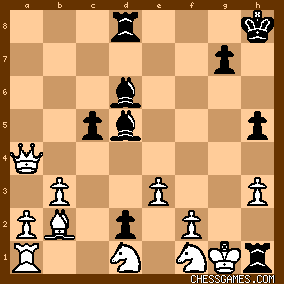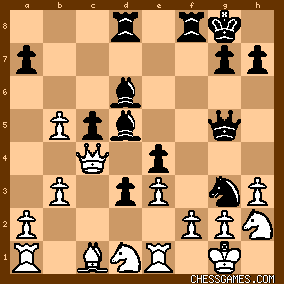|
< Earlier Kibitzing · PAGE 2 OF 2 ·
Later Kibitzing> |
| Dec-03-07 | | lopium: This Alekhine, always finds how to crush his openent. Beautiful. |
|
| Dec-03-07 | | drpoundsign: when you give up both horses to Alex you were in trouble! typical aggressive playing by black promoting pawns putting knights on high ranks. other player not in the same class |
|
| Dec-03-07 | | kevin86: Am I right to assume that black will win after: 41 ♔g2 ♕f3+ and mate at h1 Or 41 ♔g1 ♗h2+ exposes the queen.? |
|
Dec-03-07
 | | ketchuplover: What the bleep is the seven tag roster requirement for mandatory set of tags? |
|
Dec-03-07
 | | ketchuplover: null?????????????????? |
|
| Dec-03-07 | | patzer2: With 24...Ng3+! Alekhine offers a demolition decoy to begins to converts his huge space and positional advantage to a win, even though he could apparently have accomplished it a bit earlier and quicker applying the same idea with 22...Ng3+  . . |
|
| Dec-03-07 | | Calli: <legalmover24> Check out attempts by kibitzers to spell the name of the Player of the Day: Mieses vs E G Sergeant, 1935 |
|
| Feb-05-09 | | laskereshevsky: Jesus... how many time i'd study this game in my younghood! In the renowned MITTELSPIEL, the book of the great player and immense teorician PIOTR ARSENEVICH ROMANOVSKIJ, were this game is wery well commented, this opening is called "Blumenfeld's defence"... No wonder if too BENKO had deeply studied this game, before to create his own defence... isnt witty call this opening a:
"BLUMENFELD/PROTO-BENKO COUNTERGAMBIT"?! |
|
| Feb-05-09 | | mrbasso: Actually Benko didn't create the Wolga Gambit. He studied and developed it.
Here is the first game I could find in my database which is true (a6,g6,Bg7) Wolga/Benko Gambit: [Event "YUG-ch"]
[Site "Belgrade"]
[Date "1948.??.??"]
[Round "14"]
[White "Bozic, Aleksandar"]
[Black "Udovcic, Mijo"]
[Result "0-1"]
[ECO "A59"]
[PlyCount "77"]
[EventDate "1948.??.??"]
[EventType "tourn"]
[EventRounds "17"]
[EventCountry "YUG"]
1. d4 Nf6 2. c4 c5 3. d5 b5 4. cxb5 a6 5. bxa6 Bxa6 6. Nc3 d6 7. e4 g6 8. Bxa6
Nxa6 9. Nge2 Bg7 10. O-O O-O 11. f3 Qd7 12. Be3 Rfb8 13. Qd2 Nc7 14. Rac1 Rb4 15. Rc2 Rab8 16. Nc1 Nfe8 17. Nd3 R4b7 18. Rb1 Na6 19. Ne2 Nec7 20. Rbc1 f5 21.b3 fxe4 22. fxe4 Nb4 23. Nxb4 Rxb4 24. Rc4 Rxc4 25. Rxc4 Rf8 26. Rc1 Qg4 27.Qd3 Be5 28. h3 Qh4 29. Kh1 g5 30. Bg1 g4 31. Nc3 Rf3 32. Qd2 Bf4 33. Qe2 Bxc1 34. gxf3 Qxh3+ 35. Qh2 Qxf3+ 36. Qg2 Qxc3 37. Qxg4+ Qg7 38. Qc8+ Qf8 39. Qg4+
0-1
|
|
| Sep-19-09 | | Atking: <Pawn and Two> Interesting analysis. Still I'm not convinced by "your" <Here is Fritz's analysis after 14.Nh4: (.01) ( 20 ply) 14...g6, (if 14...Ne4 15.Nxe4 dxe4 16.g3 or 14...e4 15.Nf5 Qe5 16.Nxd6 Qxd6 17.Na4, in both cases with an advantage for White) 15.f3 Nb6 16.e4 d4 17.Na4 Nxe4 18.Nxg6 hxg6 19.Nxb6 axb6 20.fxe4> In this main line why not simply 15...Nd5? I can see 16.Bc4 Kg7 17.BxNd5 BxBd5 and the weakening 18.g3 which looks quite good for Black. e.g 18...Nb6 19.NxNb6 axNb6 20.e4 Be6 21.Ng2 g5 then c4 I like your post because obviously a classical player like Tarrasch never thought about such moves as Nh4 and Na4... and he was pretty wrong. Yours moves are resoucerful. What about 7.Nc3! threatening e4! I mean when one realise that Na4 isn't as bad there is no reason to be afraid of 7...d4 8.Na4 Qa5+ 9.Bd2 Qxb5 10.e3. |
|
Sep-20-09
 | | Pawn and Two: <Atking> After 14.Nh4 g6 15.f3, you indicated, <why not simply 15...Nd5?>. I must be missing some of your moves, as 15...Nd5 is not possible in the above variation. After 14.Nh4 g6, I had Fritz 11 update the old Fritz analysis. The new analysis indicates the position is still approximately equal. Here is Fritz's new analysis after 14.Nh4 g6:
(.13) (22 ply) 15.Rac1 Rc8 16.Na4 Nb6 17.Nf3 Nxa4 18.bxa4, (.00) (20 ply) 18...c4. (.02) (22 ply) 15.f3 d4 16.Nd1 Nd5 17.g3 N7b6, (.21) (20 ply) 18.a3 Bc8. (.18) (22 ply) 15.g3 e4 16.Na4 Rc8 17.Qd2 Ne5, (.11) (20 ply) 18.Rac1 Rf7. (.18) (22 ply) 15.Na4! d4 16.Rac1 Nd5 17.g3, (.27) (20 ply) 17...Kh8 18.a3. (.00) (22 ply) 15.Rad1 e4 16.Na4 Rc8 17.g3 Ne5 18.Qd2 Qe6. It is interesting that Fritz considers the best follow-up after 14.Nh4!, to be 15.Na4!. It appears that two knights on the rim, are not dim! Regarding your suggestion for White's 7th move, Fritz indicates White's top choice is: (.49) (18 ply) 7.e4 Nxe4 8.Bd3 Qa5+ 9.Nbd2. Fritz indicates White's 2nd choice is: (.45) (18 ply) 7.Nc3 Be7 (not 7...d4 8.Na4) 8.e4 d4 9.e5. 7.e3 was Fritz's 6th choice (.16) (18 ply), but this assumed Black replying 7...a6. After 7.e3 Bd6 8.Nc3 0-0, White is o.k. after (.54) (18 ply) 9.e4, or as played (.51) (18 ply) 9. Be2. In his notes, Alekhine suggested that instead of 7.e3, White could have played 7.Nbd2, followed by b3 and Bb2, with better defensive chances. Fritz indicates (-.16) (18 ply) 7.Nbd2 is inferior, as Black can reply 7...a6. After missing 14.Nh4!, Tarrasch then missed a good defensive try on his 16th move: (-.29) (20 ply) 16.h3 Ng6 17.Na4 Nh4 18.Rac1. Alekhine did not comment on either possibility: 14.Nh4! or 16.h3!. |
|
| Sep-20-09 | | WhiteRook48: Alekhine's Nimzo immortal |
|
| Oct-20-09 | | AnalyzeThis: I think that Tarrasch actually did well to survive as long as he did. |
|
Nov-12-09
 | | chancho: According to Alexander Kotov, in his book: Play like a Grandmaster, Tarrasch played very tenacious defense, but even the very best defense of a first class master cannot save a bad postion, and Alekhine found the way to make his attack crash thru. |
|
Nov-14-09
 | | Pawn and Two: <chancho> Kotov started his review of this game with White's move, 13.Qc2. Kotov gave 13.Qc2 an exclamation mark, and stated that Tarrasch had thought up an excellent defensive plan to guard his f2 and h2. After White's 18.Nf1, Kotov stated, <White has carried out his plan, but even the finest play cannot save a bad position,...>. However, Kotov, Alekhine, and Tarrasch all overlooked the move 14.Nh4! This move would have given White a very good chance to maintain an approximately equal position. Tarrasch's 14.Rfe1? was an error, and his move 16.Nd1?? was catastrophic, allowing Alekhine to quickly overwhelm the White position. Neither Alekhine or Kotov made any note of these errors in their notes to this game. An updated review by Fritz 12 indicates: 14.Nh4! g6, (.15) (23 ply) 15.g3 e4 16.Na4 Rc8 17.Qd2 Ne5 18.Rac1, or 15.Na4 e4 16.g3 Rc8 17.Qd2 Ne5 18.Rac1, with an approximately equal position. After 14.Rfe1? e4! 15.Nd2 Ne5, White's best chance was: (-.39) (21 ply) 16.h3 Ng6 17.Na4 Nh4, (-.60) (20 ply) 18.g3 Nf5 19.Bf1 Nd7 20.Bg2 Ne5 21.Bxe5 Qxe5 22.Qc3. After 16.Nd1?? Nfg4, White had a clearly lost position, (-1.69) (22 ply) 17.g3 Qe6 18.Bxe5 Nxe5 19.Qb2 Nd3 20.Bxd3 Be5 21.Qc1 Bxa1 22.Qxa1 exd3, or, as in the game continuation, (-1.87) (22 ply) 17.Bxg4 Nxg4 18.Nf1 Qg5 19.h3 Nh6. Tarrasch's position at move 14, required an almost superhuman defense. It is not surprising that Tarrasch missed his way, and that Alekhine and Kotov missed noting White's best defensive possibilities. |
|
| Nov-26-09 | | jmboutiere: 9.e4 + 0.50; 9Be2 + 0.23 Rybka 3
14.Rfe1 - 0.14; 14.Na4 + 0.12
16.h3 + 0.09; 16.Nd1 - 0.37
17.h3 - 0.52; 17.Bg4 - 0.65
20.Kh1 - 1.58; 20.Rc1 - 0.99
22.Bc1 - 4.98; 22.Rc1 - 1.50
22...Ng3 - 5.19; 22...d3 - 2.83;
26...Ne2 - 3.84 |
|
| Dec-07-09 | | Dravus: Siegbert trashed. |
|
| Jul-17-10 | | Sleeping kitten: Alekhine gives the following nice variation. If 36. ♕c6 in order to protect g2 by ♕xe4, then 36...♖f3 37.♕xe4 ♗d5 38.♕a4 ♕xg2+!!

click for larger view
39.♔xg2 ♖g3+ 40.♔h2 ♖g2+ 41.♔h1 ♖h2+ 42.♔g1 ♖h1≠.

click for larger view
A nice staircase, isn't it ? |
|
| Sep-12-11 | | hedgeh0g: I like to play this opening for Black and I have to say the way White handled the opening is a gambit player's dream: ceding the centre, allowing the easy development of Black's pieces and doing very little to pursue counterplay on the light squares. The most critical test of this gambit is 7.Nc3, preparing an immediate e4! to challenge Black's centre. This typically results in a very sharp game where White obtains an advantage with careful play. I think it's worth considering 6...a6 as an alternative to the immediate ...d5 in order to avoid some of the messier lines. |
|
May-16-12
 | | jessicafischerqueen: This game (round one) was awarded a brilliancy prize. <Alekhine> finished shared 2d with <Spielmann>, 1/2 point behind winner <Bogoljubov>. |
|
| May-17-12 | | whiteshark: <Calli: ... In fact, in the game, Alekhine misses the quickest win with <22...Ng3+>>. That's right. 
click for larger view The point is that square d5 is now covered by the black Queen, so that after <23.Kg1> (23.fxg3 is forced mate, e.g. 23... Qxg3 24.Nf3 exf3 25.Qc4+ Rf7 26.Qxf7+ Kxf7 27.Rg1 Qh2#) <23... d3> when <24.Qc4+> will be answered by <24...Bd5!> and White will lose another tempo. The position is lost anyhow. 
click for larger view. |
|
| Feb-08-13 | | justin2seo: excellent and crushing and nice kingside attack!! |
|
Jun-20-20
 | | fredthebear: This brilliancy prize game has appeared in numerous chess books written by Alekhine, Chernev, Reinfeld, ROMANOVSKIJ, Reti, Kotov, Vukovic, Lipnitsky, McDonald, Tarrasch, Tartakower & du Mont, etc. * Some history of this tournament: https://tartajubow.blogspot.com/201... |
|
| Jun-21-20 | | The Kings Domain: Well executed game by Alekhine. His ominous and menacing build up to his attack is appealing. |
|
| Sep-19-23 | | rmdalodado: I would like to suggest checking the game starting from Move 31 for black as book lines (ex. Game 62 from Alekhines best games (1908-1937 or Game 93 from Golden Dozen by Chernev) deviates from the move (31 .... d2 instead of 31 .... Ne2+ here). Thanks |
|
 |
|
< Earlier Kibitzing · PAGE 2 OF 2 ·
Later Kibitzing> |





